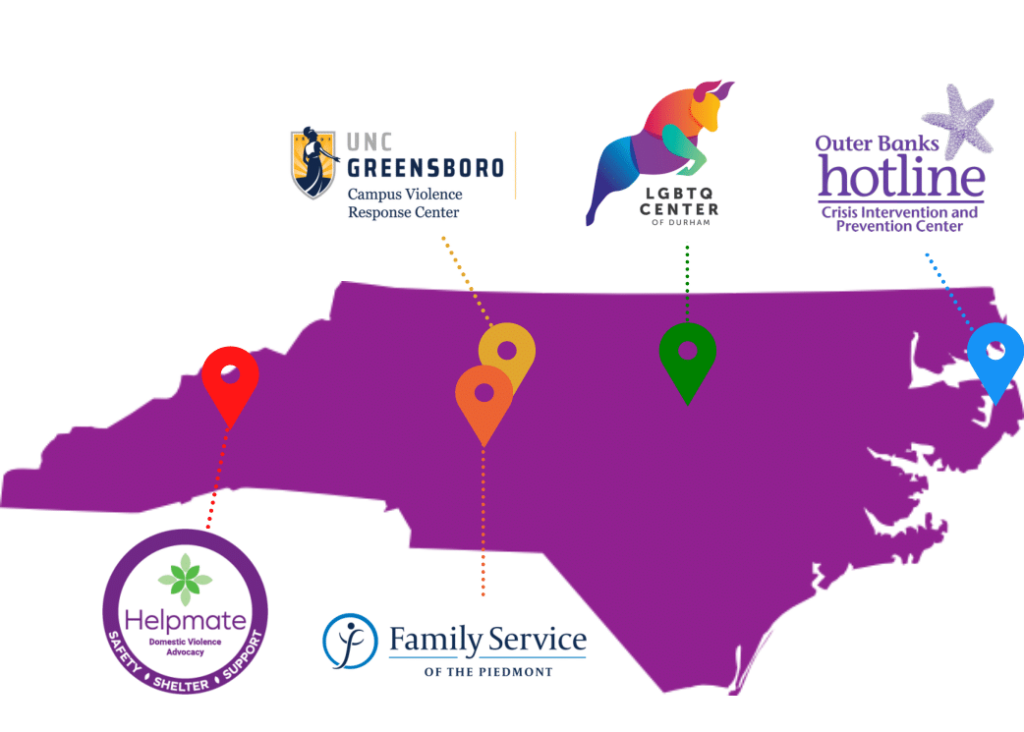Project Safe Neighborhoods
Project Safe Neighborhoods (PSN) is a national model that brings together federal, state, local, and tribal law enforcement officials, prosecutors, community leaders, and other stakeholders to identify the most pressing violent crime problems in a particular jurisdiction or community, and develop comprehensive, targeted solutions to address them. The four components of PSN are focused deterrence, prevention and intervention, community engagement, and accountability across partners. PSN also incorporates research and data analysis, and lessons learned from other violent crime reduction initiatives to inform local decision-making in implementing the most effective violence reduction strategies.”
Focused Deterrence
The focused deterrence component relies on joint police-community partnerships to identify and “notify” chronic/violent offenders that violent crime will not be tolerated in a given locality.
Specifically, the focused deterrence component of PSN:
- Identifies problem/chronic violent and gang offenders in geographical areas of concentration
- Investigates and prosecutes the most violent groups and individual offenders within areas of concentration
- “Notifies” identified, targeted offenders—with face-to-face communication in community-based settings—that violence will not be tolerated and offers social assistance services to those who choose to remain crime-free
- Follows through with aggressive prosecution of those who continue engaging in violence and proactive delivery of needed resources to those who choose to change
- Evaluates what works and repeats the strategy to work toward institutionalization
- Standardizes the identification process through a regular violent gun case screening
Prevention & Intervention
The Prevention and Intervention component of PSN recognizes that any long-term, sustainable reduction in violent crime must be based on transforming those systemic factors—at society, community, and individual levels—that lead people to begin engaging in crime in the first place.
- Specifically, “prevention” refers to community-wide efforts to mitigate collective risk factors and provide protective factors to youth. It is often hard to measure the success of prevention programs, but they do have long-term impacts when they are sustainable and rooted in specific communities.
- “Intervention” refers to targeted efforts to stop specific groups or individuals from committing violent crimes or providing them with immediate services after they have committed or been the victims of violent crimes. Intervention programs are most effective when they are implemented by “credible messengers” and target particular people. When successful, intervention programs will have immediate impacts on violent crime rates in specific geographical areas.
Community Engagement
The Community Engagement component is founded on the reality that any gun violence reduction strategy must authentically incorporate those individuals and communities most impacted by gun violence.
Specifically, the Community Engagement component of PSN:
- Invites local community-based organizations and non-profits to collaborate with law enforcement and other PSN partners in defining the most pressing violent crime problems and possible solutions in a given locality
- Facilitates ongoing spaces for community-based organizations and individuals to provide their perspective on the PSN strategy
- Leverages community voices and resources to strengthen other elements of the PSN strategy such as focused deterrence and prevention & intervention
Partner Accountability
The Partner Accountability component is built on the trust that comes with transparency in implementation of the PSN process, which is built on data-driven best practices.
Specifically, the Partner Accountability component of PSN:
- Invites all relevant law enforcement and prosecutorial agencies in a given jurisdiction to collaborate in implementing the PSN model
- Ensures that collaboration across partners is structured by formal, signed Memorandums of Understanding that outline processes and protocols
- Utilizes ongoing meetings and data-driven best practices to create transparency and trust to sustain partnerships
Past Projects
The North Carolina Network for Safe Communities (NCNSC) has facilitated a North Carolina Community Resource Coordinator (CRC) Network, a statewide network for community resource providers to share information and exchange ideas concerning focused deterrence work in North Carolina. The group meets quarterly and includes resource coordinators from sites across the state and representing all three federal judicial districts.
The goals of the CRC Network are to share best practices in the field, provide a forum for easy and accessible information sharing, and to support others who are currently working in this field. Meetings and a blog site are a couple of mechanisms we use to accomplish these goals. Most of the community resource and service providers are engaged in sites operating under the Project Safe Neighborhoods (PSN) moniker. PSN is a nationwide commitment to reduce gun and gang crime in America by networking existing local programs that target gun and gun crime and providing these programs with additional tools necessary to be successful. Given PSN’s organization at the federal level, NC CRC Network is organized into NC’s three federal judicial districts: the Western District, the Middle District, and the Eastern District.
North Carolina is one of only a few states implementing focused deterrence at a statewide level. Therefore, the knowledge and information base within the state is vast. As such, NCNSC acknowledges the importance of convening site partners to share best practices and serves to capture best practices and lessons learned from the Network. NCNSC is writing up the latest best practice brief from the August 2014 CRC Network meeting which pertains to community engagement/participation in law enforcement partnerships. The final brief will be uploaded soon to this website.

The Educating Kids about Gun Violence (EKG) program is part of the Fayetteville Police Department’s Operation Ceasefire initiative, The EKG program began in 2014 and is designed to teach kids about gun and gang violence and prepare them for healthy decision-making. The program is taught by Fayetteville Police Department officers to youth in all 7th and 9th graders in the Cumberland County School System, representing a unique partnership between law enforcement and the schools. By the end of the 2014-2015 school year, the Department will have reached over 8600 students county-wide with its gun and gang violence prevention and education message.
The EKG program uses a video of a scenario of a young male who is faced with various decision points about gun and gang violence. The video exposes the classroom participants to the potential consequences of poor decision making about guns and gangs. Classroom participants then discuss decision-making and how the young male in the video could have made better decisions along the way to prevent the negative consequences he experienced in the video.
Based on preliminary data analyzed by the NC Network for Safe Communities team stemming from surveys completed by student participants, the EKG program has been administered to a sample of students where nearly half have already experienced a close family or friend who has been shot with a gun. Overall, 2.2% of student participants are already in a gang and another 3.5% would consider joining a gang. About 12% had either been shot at or threatened with a gun themselves and another 3.3% reported that they have used a gun to threaten or shoot at another person. Over 20% of student participants reported that it would be easy to get a gun if they wanted one and nearly 8% said that their friends carried guns regularly. Nearly 10% of the student participants reported that they have already felt pressure from others to carry guns themselves. The descriptors of the sample suggest that the EKG program is targeting a rather vulnerable or at-risk population of students, many of whom are already experiencing some level of gun and gang-related violence in their lives. Even still, the changes in attitudes and intended behaviors toward guns and gangs as a result of the EKG program are very promising. Students showed statistically significant (p ≤ .05) attitudinal/cognitive and intended behavioral shifts in the desired direction from pre- to post-survey, indicating that exposure to the EKG training program was successful in leading to student attitudinal, behavioral, and cognitive changes. Specifically, students reported the following shifts after exposure to the EKG training based on their pre- and post-survey data.
In addition, on the post-survey, 58.2% of students strongly agreed and another 35.1% agreed that they have choices
when it comes to making good decisions. 51.7% of students strongly agreed and 38.6% agreed that after the program,
they feel like they will be able to make better decisions in their life. 53.7% of students strongly agreed and 29.0% agreed
that after the program, they would be less likely to carry a gun. 59.8% of students strongly agreed and 30.3% agreed that
after the program, the feel like they know more about the dangers of having a gun. Finally, 62.7% of students strongly
agreed and 29.0% agreed that after the program, they leaned that they need to think more about the consequences of
their actions before acting.
Even more compelling are the anecdotal stories coming from the officers who facilitate the EKG sessions about student reactions and revelations about their own experiences related to gang and gun violence. Officers always leave their direct contact information with the students at the end of each session and many students have reached out to officers forging true relationships and building trust around this sensitive matter of violence in their everyday lives.
We look forward to continuing our partnership with the Fayetteville Police Department on the EKG program. Final evaluation results will be forthcoming thanks to funding from the North Carolina Governor’s Crime Commission for the NC Network for Safe Communities team to complete the evaluation work.
For more information about the EKG program, contact A. Njeri Fikes, Community Engagement Coordinator for Operation Ceasefire at afikes@ci.fay.nc.us Be sure to tell them we sent ya!
Beginning in 1995 as the Boston Gun Project, and evolving into Operations Ceasefire, focused deterrence aimed at reducing gang violence took root. Violent gang members were targeted, delivered the message that violence would no longer be tolerated, and the message was enforced with a “pulling levers” approach. At the same time, gang members were offered assistance if they so chose to take it, but violence after the notification was met with an immediate and intense law enforcement response.

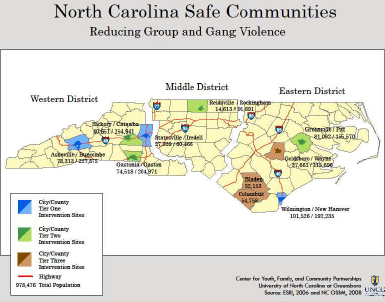
In the years preceding Operations Ceasefire, youth homicides in Boston had increased 230%, with an average of 44 youth homicides per year from 1991-1995. After implementation of Operations Ceasefire, there was 63% decrease in youth homicides and a 25% decrease in youth gun assaults.
North Carolina Safe Communities (NCSC)
In North Carolina, ten sites were funded through the Governor’s Crime Commission to implement a group violence focused deterrence initiative with training and technical assistance provided by UNCG. Similar to PSN, NCSC sites used data to drive strategy, including the selection of crackdown groups, trigger incidents, and who to notify.
In High Point, NC in 2004, the drug market initiative (DMI), often referred to as the “High Point Model”, was implemented and worked to completely shut down targeted open air drug markets seemingly overnight. Since then, similar drug market initiatives have succeeded in locales nationwide.
How it works
Using a focused deterrence strategy characterized by law enforcement and community partnerships, a clear message is delivered to selected drug dealers that the dealing has to stop. the most violent dealers are arrested prior to the call-in and they serve as an example to notify offenders. Cases are banked against non-violent offenders and during notifications, it is made clear that the community cares for the offenders, but rejects their conducts. Resources are available for those who want them and continued drug dealing will result in the activation of banked cases against offenders.
Success
Nontraditional enforcement methods to combat drug markets have historically taken a heavy toll on police-community relations. But, the new focused approach of notifying the small number of dealers who drive overt drug markets has been able to nearly eliminate this type of markets with low level of arrest and prosecution, helping to rebuild community-police relations.
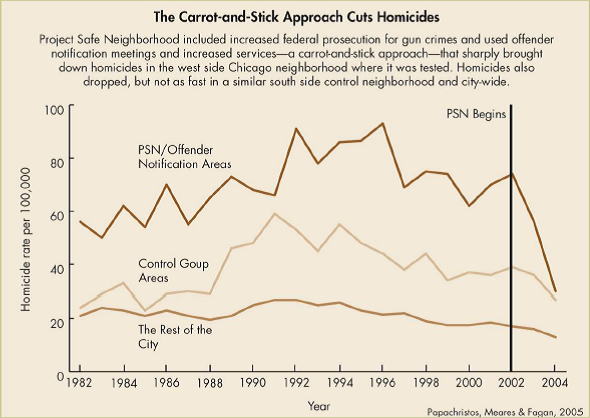
The Middle District of North Carolina (MDNC) has had great success implementing focused deterrence strategies across at least 11 sites. UNCG’s NC Network for Safe Communities created a Brochure to document MDNC sites’ successes in 2012.
Given that a small number of offenders drive the majority of violent crime, it makes sense to implement a crime reduction strategy aimed specifically toward these offenders. The focused deterrence model has proven effective for reducing crime among chronic violent offenders. This is true no matter at what stage an offender is notified in their criminal career. Some have notified just prior to release from prison or jail. Others have been notified with they are still out in the community. When faced with stiff penalties and a collaboration of law enforcement at the local, state, and federal levels, as well as community representatives, the message is pretty clear. Stop the violence, or face severe and certain consequences. When standards are violated, authorities will “pull every lever” available to ensure that violators are punished.
OFFENDER FOCUSED DOMESTIC VIOLENCE INITIATIVE
The North Carolina Network for Safe Communities (NCNSC) at UNCG received COPS funding to conduct a full impact evaluation of the Offender Focused Domestic Violence Initiative in High Point, NC along with evaluation and T/TA of the strategy as it is replicated in Lexington, NC.
Evaluation esults suggest that victim harm, volume of domestic-related arrests and calls for service, and domestic violence offender recidivism have all decreased in High Point since the strategy began in February 2012. For the full evaluation and implementation report from the NCNSC research team (Sechrist, Weil, & Shelton, 2016), click: COPS OFDVI Lexington – High Point Evaluation – FINAL
The graphic to the right demonstrates the recidivism rates in both High Point and Lexington for domestic violence offenders who have received a notification message.
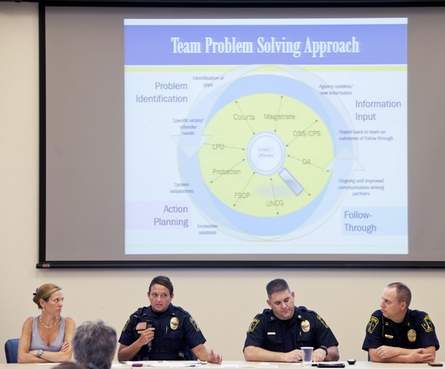
NCNSC presented along with partners at Lexington Police Department on the one-year outcomes in Lexington, NC to the domestic violence initiative working group partners and the larger community. At this celebrated occasion, in July 2015, two victims shared their experiences of how the criminal justice system has responded to their needs much more effectively since the domestic violence initiative has been implemented. One victim in particular was able to share the story of how she was treated by law enforcement officers who responded to her call for service in another jurisdiction. The officers were dismissive, insensitive, and nothing was done to her offender. She stated that officers even made jokes about the incident while at the scene. When the same victim shared the response she received in Lexington, she was very grateful to law enforcement and was overwhelmed by the positive and proactive response she received– eventually resulting in her offender being jailed and held accountable for his actions. In addition to the successes told by the victims, a representative from Child Protective Services in the Department of Social Services spoke about how through the initiative, partners have worked together more closely and through the partnership, responses to child-involved incidents of domestic violence have become more effective. Lexington is now touting an approximate 14% recidivism rate for notified domestic violence offenders and a victim injury rate in domestic violence incidents that is lower than the national average. To access a copy of the presentation, click: LPD 2015 One Year Update Presentation.
Also, NCNSC has released an interim analysis of domestic violence offenders who have been notified through the High Point Police Department’s focused deterrence initiative. The findings from the analysis reveal that we know quite a bit how well the strategy is working in reducing domestic violence recidivism and with what types of offenders.
First of all, in general, the strategy of notifying domestic violence offenders that the police department now has a new way of dealing with domestic violence and is taking domestic violence crimes seriously works to deter future domestic violence recidivism.
The notification message goes onto to say that we [the police department] know who you are and you are now on a list being tracked for any future domestic violence offenses. Further domestic violence will result in swift, certain, and severe consequences. The offender’s anonymity is stripped and the offender is told that the victim is no longer driving the process. The police department is now taking charge. A seemingly simple concept has had rather astounding results when compared to traditional approaches to deter domestic violence. The graph below from the interim report shows the 6-month and 1-year recidivism rates for notified offenders across offender categories in High Point.We have found that certain offenders are more likely than others to recidivate after notification at both the C and D levels.
First, the domestic violence history of an offender matters in whether or not they are likely to reoffend after notification. For both C- and D-level offenders, if they had a prior arrest for domestic violence before notification, they were more likely to reoffend after notification than offenders who did not have a prior domestic violence arrest. Therefore, it helps to know who is being notified based on their past arrest history and there may be room for adjusting the notification message or delivery method to account for past history in hopes of making the notification more successful in deterring future domestic violence for high-risk offenders. While most C-notified offenders (82.7%) did not reoffend after notification, 17.3% did reoffend. When looking at the C-level reoffenders, 60% had a prior domestic violence arrest before notification compared to only 32% of offenders who did not reoffend after C-notification. C-list reoffenders also had significantly more total domestic violence arrests prior to C-notification (1.35 prior domestic violence arrests on average) compared to non-reoffenders (.67 prior domestic violence arrests on average). A similar trend was found for D-notified offenders. Most D-notified offenders (77.6%) did not reoffend after notification with reoffenders being slightly more likely than non-reoffenders to have had a prior domestic violence arrest before notification.
Age of the offender at the time of their 1st domestic violence arrest is important in predicting whether the offender will reoffend after notification. Non-reoffenders were statistically significantly older at the age of first domestic violence arrest as compared to reoffenders. The average age of first domestic violence arrest for C-level reoffenders was 30.1 years which was significantly younger than non-reoffenders whose average age of first domestic violence arrest was 32.5 years. However, there was no significant difference between age at notification for C-list reoffenders and non-reoffenders. For D-list offenders, age at notification was associated with whether or not the offender reoffend after notification. D-notified reoffenders tended to be slightly younger at time of notification (average age at notification was 33.1 years) compared to non-reoffenders (average age at notification was 36.2 years). Like with the C-list trend, D-list reoffenders tended to be younger at age of first domestic violence arrest (average age was 30.9 years) compared to non-reoffenders (average age was 33.0 years). See the graphic below from the interim report for more detail.
Certain offenders reoffend very quickly after notification and they are very likely to reoffend again as they escalate up the offender notification categories. Specifically, if an offender quickly reoffended after D-notification (defined as getting a new domestic violence arrest within 180 days of initial notification), they were more likely to reoffend again after C-notification as compared to D-notified offender who were not quick reoffenders. 38% of Quick Reoffenders after D-notification went onto to reoffend after C notification. See graph below from the interim report for more details.
What do we do now with what we know?
The full interim report can be accessed here: Nov 2014 Interim Report_UNCG Notified Offenders OFDVI Evaluation
Background of the Strategy
The High Point Police Department in partnership with the High Point Community Against Violence, Guilford County District Attorney’s Office, Family Service of the Piedmont, and researchers at the University of North Carolina at Greensboro have implemented a focused deterrence strategy to combat domestic violence. The initiative known as, Offender Focused Domestic Violence Initiative (OFDVI) has been in effect for over three years beginning in February 2012. The low recidivism rates for domestic violence offenders after OFDVI implementation are staggering given the recidivism rates for domestic violence offenders presented in the literature, which range from 20-34% (Hanson, Helmus, & Bourgon; Hendricks, Werner, Shipway, & Turinetti, 2006; McCormick, Cohen, & Plecas, 2011; Ventura & Davis, 2001; Williams & Houghton, 2004) with the majority occurring within six months of their initial assault.
The OFDVI strategy represents for the first time anywhere, the application of the evidence-based focused deterrence approach to the problem of domestic violence and a shift to an offender focus in combatting domestic violence. With the OFDVI approach, law enforcement and resource efforts are focused on those offenders who are identified by level of interpersonal violence, frequency of violence, and an analysis of their legal exposures, and these offenders are notified that their violent behavior will no longer be tolerated and what the specific sanctions will be for those who reoffend after notification. By focusing on the offender, the OFDVI strategy attempts to avoid re-victimization of victims by alleviating systematic barriers in the judicial process.
More Evaluation Results/Preliminary Findings
Click here to download a May 2014 presentation about the OFDVI strategy and most up-to-date evaluation results: NCCADV 2014 Conference Presentation
Click here to download a February 2014 presentation about the OFDVI strategy: Innovations 2014 Conference Presentation FINAL
Click here to download a November 2013 presentation to the American Society of Criminology: ASC 2013 Conference Presentation FINAL
Changes in Process Responses to Domestic Violence
To shift the focus to the offender, the OFDVI strategy is designed to address issues or gaps within the criminal justice system itself that has socialized domestic violence offenders to perceive that they will receive only minor consequences for their offenses, and has led offenders and victims to believe that domestic violence is not an issue of importance to the criminal justice system and the community. As these perceptions become reality for many offenders and victims, the lack of swift and certain consequences has emboldened offenders to continue with their violence and escalate their behavior over time which could result in serious injury or even death for victims.
To enact change in the criminal justice system’s response to domestic violence, there have been changes in the attitudes and behaviors of key players in the system, specifically the courts and law enforcement personnel who deal with the perpetrator. The OFDVI strategy is built upon a partnership designed to enact change at all levels of the system through constant monitoring of the system, ongoing feedback from parties involved in the system, and a willingness of system players to be open to criticism and be willing to change or affect change in others. See graphic to the right. One of the critical features of the OFDVI strategy is the ability to focus on offenders by targeting them at earlier stages of offending, before the secrecy of offending entrenches and the violence escalates, is a unique and important facet, particularly since research suggests that early intervention is key in stopping the cycle of domestic violence.
The implementation process documentation prepared by NC Network for Safe Communities is available here: OFDVI Process Documentation FINAL
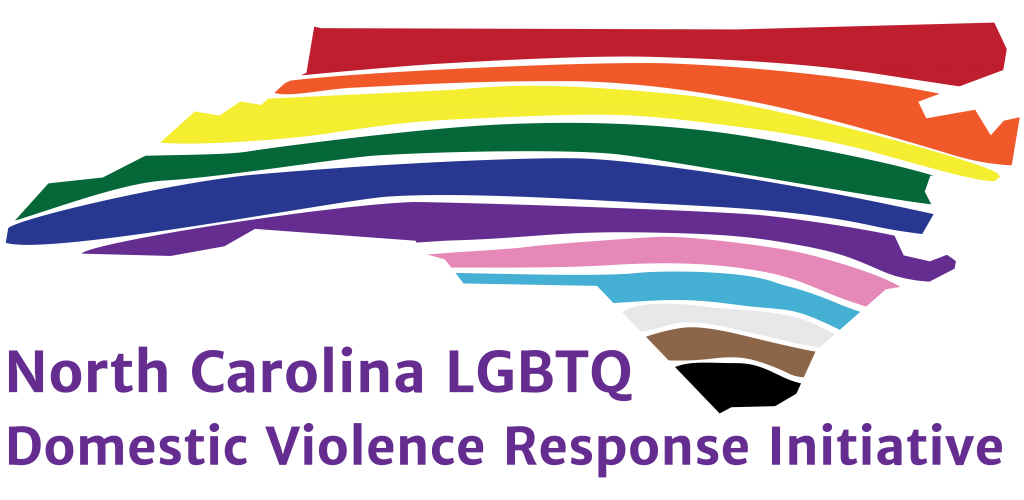
The NC LGBTQ Domestic Violence Response Initiative is a statewide partnership between the University of North Carolina at Greensboro, three community-based domestic violence service provider agencies, one university-based service provider, and one community-based LGBTQ center. The goal of the Initiative is to increase the capacity of communities to provide safe, affirming, and quality service to LGBTQ-identified survivors of domestic violence.
This project was supported by Grant No. 014256 awarded by the North Carolina Governor’s Crime Commission. The opinions, findings, conclusions, and recommendations expressed in this presentation are those of the author(s) and do not necessarily reflect the views of the state of North Carolina or the U.S. Department of Justice.
